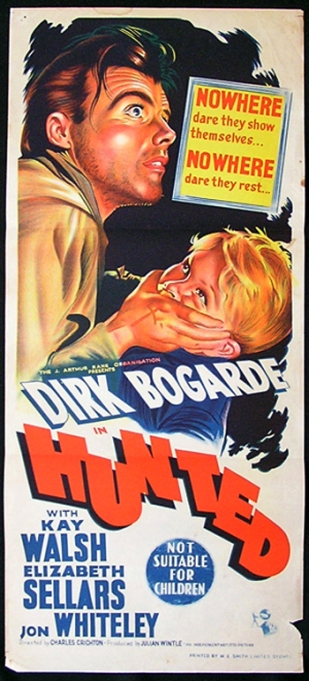
Directed by Charles Crichton, Hunted is a crime drama in the form of a chase film and stars Dirk Bogarde and Jon Whiteley (here in his debut film, aged 6).
In the 1950s, Dirk Bogarde was known for playing mainly sailors or soldiers, or the nice Dr. Sparrow in the Doctor movies or else occasionally complete sociopaths!
Of these, the sociopaths are by far the most interesting for they were often murderers and crooks. So at first glance this film seems like another Dirk-as-crook … this time on the run.
But it pans out to be something much more complex.
PLOT
Robbie (Jon Whiteley), an orphaned 6-year-old boy in care, escapes into the London streets and takes shelter in a derelict bomb site, where he stumbles across Chris Lloyd (Dirk Bogarde) and the body of a man Lloyd has just killed. Aware that Robbie is the only witness to his crime, Lloyd realises that he will have to get out of London and that he has no option but to take the boy with him.
The film follows the pair as they travel north with the police in pursuit, and charts their developing relationship. Initially Lloyd dismisses Robbie, as an inconvenience, while Robbie is wary and suspicious of Lloyd. As their journey progresses they gradually develop a common cause, both having burned their bridges and having nothing to lose.
But when Lloyd finally sees a chance to escape, he finds a difficult choice faces him.
IN RETROSPECT…
 This was one of Dirk Bogarde’s favourite films, which also functions now as a record of post-war Britain – of bomb sites and tramcars; of horse-drawn traffic in London and the long gone pottery factories of Stoke-on-Trent, which were still belching smoke. The railway scenes were filmed on lines that fell to Dr Beeching’s axe in the 1960’s.
This was one of Dirk Bogarde’s favourite films, which also functions now as a record of post-war Britain – of bomb sites and tramcars; of horse-drawn traffic in London and the long gone pottery factories of Stoke-on-Trent, which were still belching smoke. The railway scenes were filmed on lines that fell to Dr Beeching’s axe in the 1960’s.
It is also a social record of post-war austerity and ration books, of police with no radio communications or computers or helicopters.
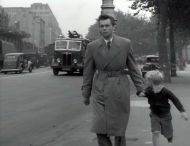 These days a man abducting a little boy can mean only one thing, but no such assumptions pertain here: in fact one the police officers in this film has to confess that he can’t understand what Lloyd would want with a little boy.
These days a man abducting a little boy can mean only one thing, but no such assumptions pertain here: in fact one the police officers in this film has to confess that he can’t understand what Lloyd would want with a little boy.
What makes this film memorable is that it is interested in something far more complicated than a modern day film would probably make it – for these two unlikely fugitives of different ages and copmpletely different chatacter, agree to team up for their own reasons; neither can go home and when it comes down to it, all they have is each other.
GENRE
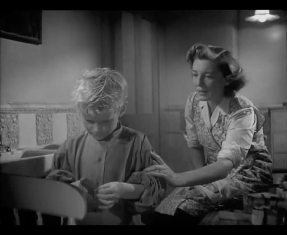 Above I have called this a crime drama in the form of a chase film but others have asked whether it is really a Brit film noir? These characters are buffetted by fate, they exist on the margins of society. Perhaps it is an early Brit road movie? Or is it a fugitive epic, concerning the nature of parenthood and with universal themes as deep as an old Icelandic saga?
Above I have called this a crime drama in the form of a chase film but others have asked whether it is really a Brit film noir? These characters are buffetted by fate, they exist on the margins of society. Perhaps it is an early Brit road movie? Or is it a fugitive epic, concerning the nature of parenthood and with universal themes as deep as an old Icelandic saga?
After all there is no end to this journey they both take – a journey of constant worry and heart-rending tribulation, of a lost man who has over-reacted to a shock in a “crime of passion”, and who then finds himself in an even more terrible situation with this young companion who is escaping the tortures of a wicked step-father.
For Lloyd is not just a mindless killer – as you might find in a whodunnit: the motives for what he has done are not cut and dried. Similarly the boy is not just some scared kid – he has been abused and we come to understand that in some ways he is better off on the run with a killer than staying in the care of a step-father or indeed the state!
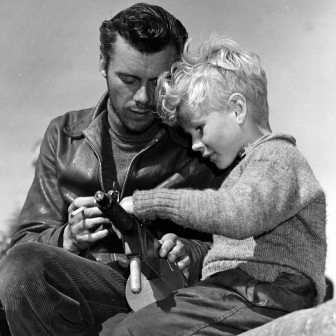 TRIVIA
TRIVIA
As it turns out, this film’s story of people of different ages teaming up has a real life aspect. Born on February 19, 1945 in Monymusk, Scotland, Jon Whitely was an amazingly talented child star who started by winning first prize for a poetry recital at the Aberdeen Music Festival at the age of only 6.
This led to a film appearance in this highly auspicious debut. For his second film, The Little Kidnappers (1953) he, along with fellow child co-star Vincent Winter, was awarded an honorary, miniature “Juvenile Oscar” at the Academy Awards ceremony of 1954.
He next appeared as Fritz Lang’s young protagonist in Moonfleet (1955) opposite Stewart Granger, then in The Weapon (1956), in which he played a lad who accidentally shoots his friend with a gun used long ago in a murder. Finally, in The Spanish Gardener (1956), he played the lonely son of a British consul living in Madrid who finds solace with (again) Dirk Bogarde as the title character.
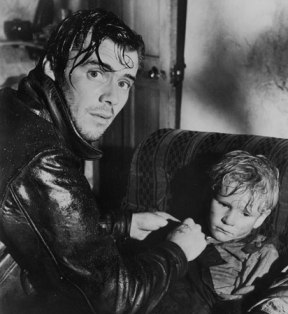 Whiteley got along famously with the young matinee idol who was then just coming to prominence and was still quite rebellious.
Whiteley got along famously with the young matinee idol who was then just coming to prominence and was still quite rebellious.
Bogarde once confessed in a TV interview that he felt so warm towards young Whiteley that he wanted to adopt him. Rather than a serious consideration (Whiteley’s parents certainly would not have been up for it!), this should be read as an expression of Bogarde’s wish to protect the boy.
Accutely aware of the hazards of celebrity, Bogarde would never have really contemplated this – his life at this time was difficult enough!
In a recent interview Whiteley said that Bogarde struck him as secretive and guarded, always avoiding fans.
By the time they came together again for the Spanish Gardener 4 years later Bogarde had become “more self regarding” and “had a slight chip on his shoulder, which was extremely puzzling for someone as successful as he was. There was a bitterness in the way he spoke.”
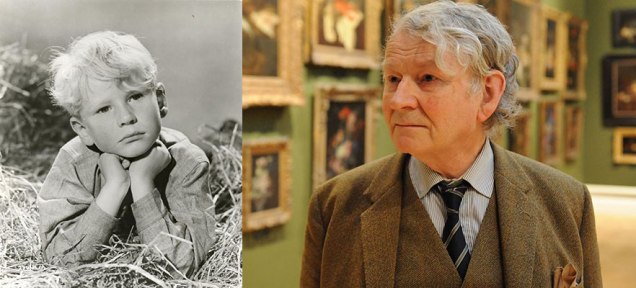
Whiteley and Bogarde lost touch after The Spanish Gardener and, following a tiny spate of TV appearances, Whiteley’s film career also came to an end – just as his parents had planned. They had allowed this filmic disruption to his education only on condition that he give it all up in time for the Eleven Plus exam.
Whiteley’s Oscar arrived through the post – the school term had prevented him from attending the ceremony in Los Angeles. Anyway, the boy had other interests. “As an eight year old I was always fond of art and archaeology”, he recalled in an interview from the position he has held as art historian at the Ashmolean Museum in Oxford since 1976.